Last weekend, Tara Black attended a masterclass on how to create a picture book, led by Joy Cowley. This was a fundraiser for Featherston Booktown, which Joy is the patron of. This is presented in graphic format, but with a full transcription of each page in order at the bottom of the article, for accessibility.
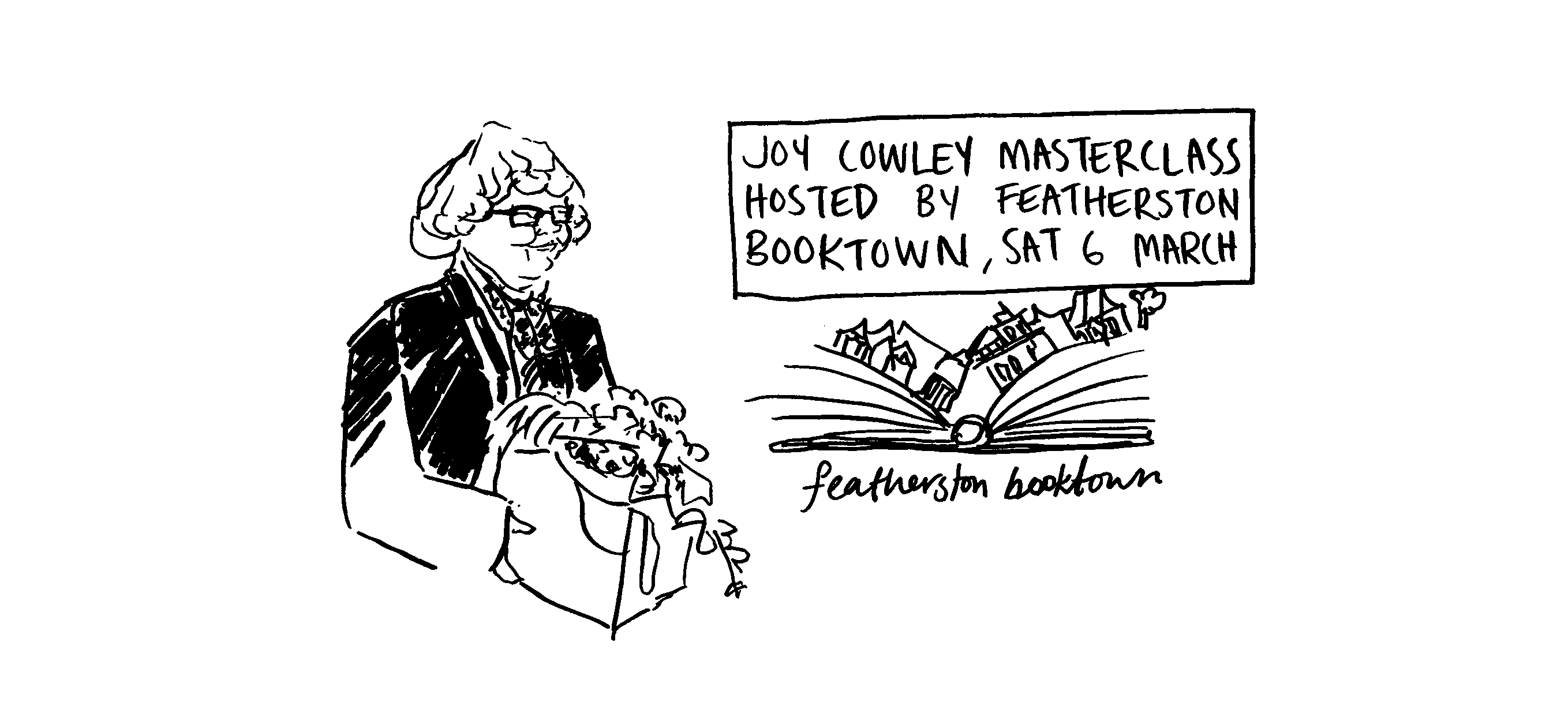
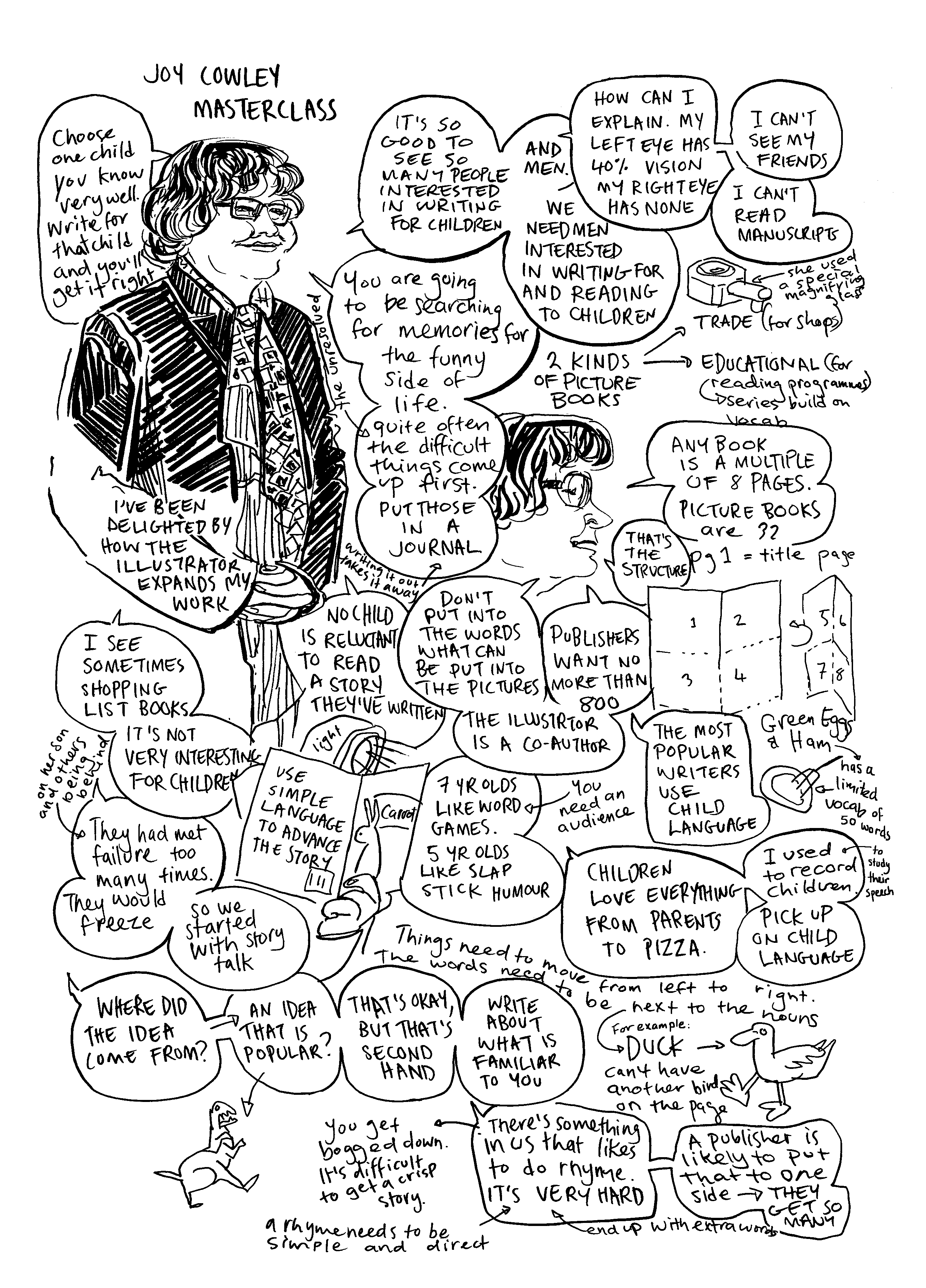
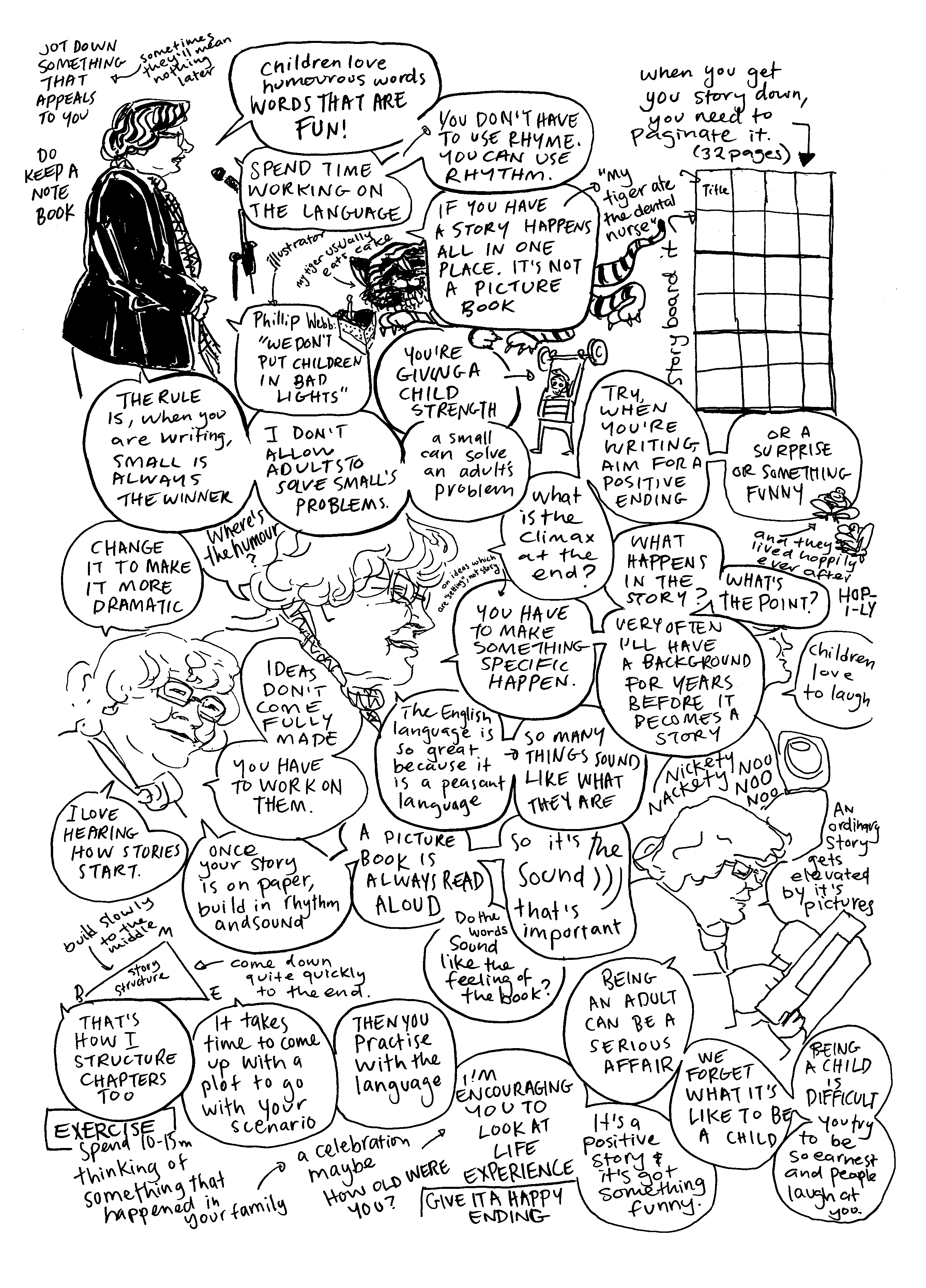
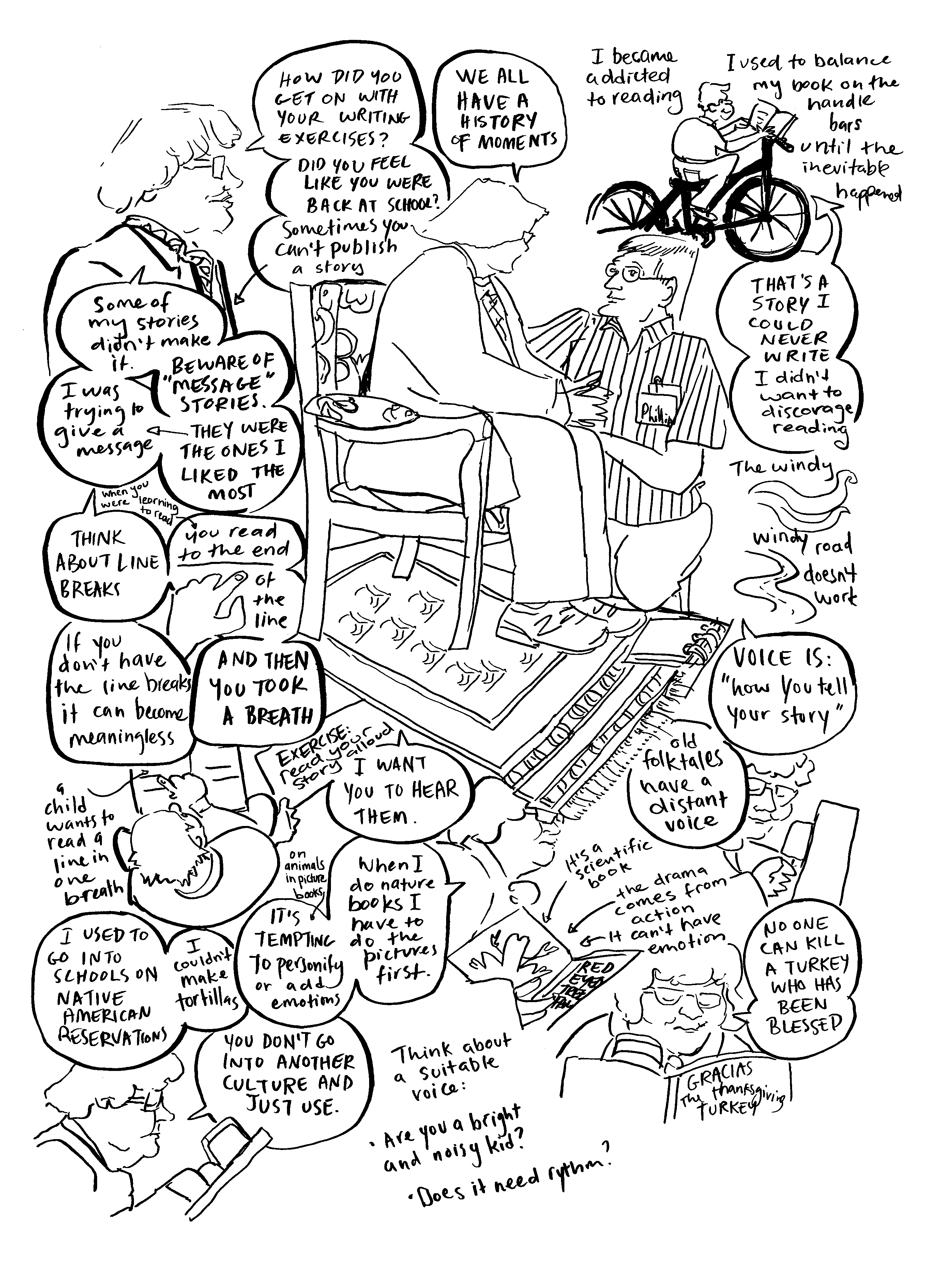
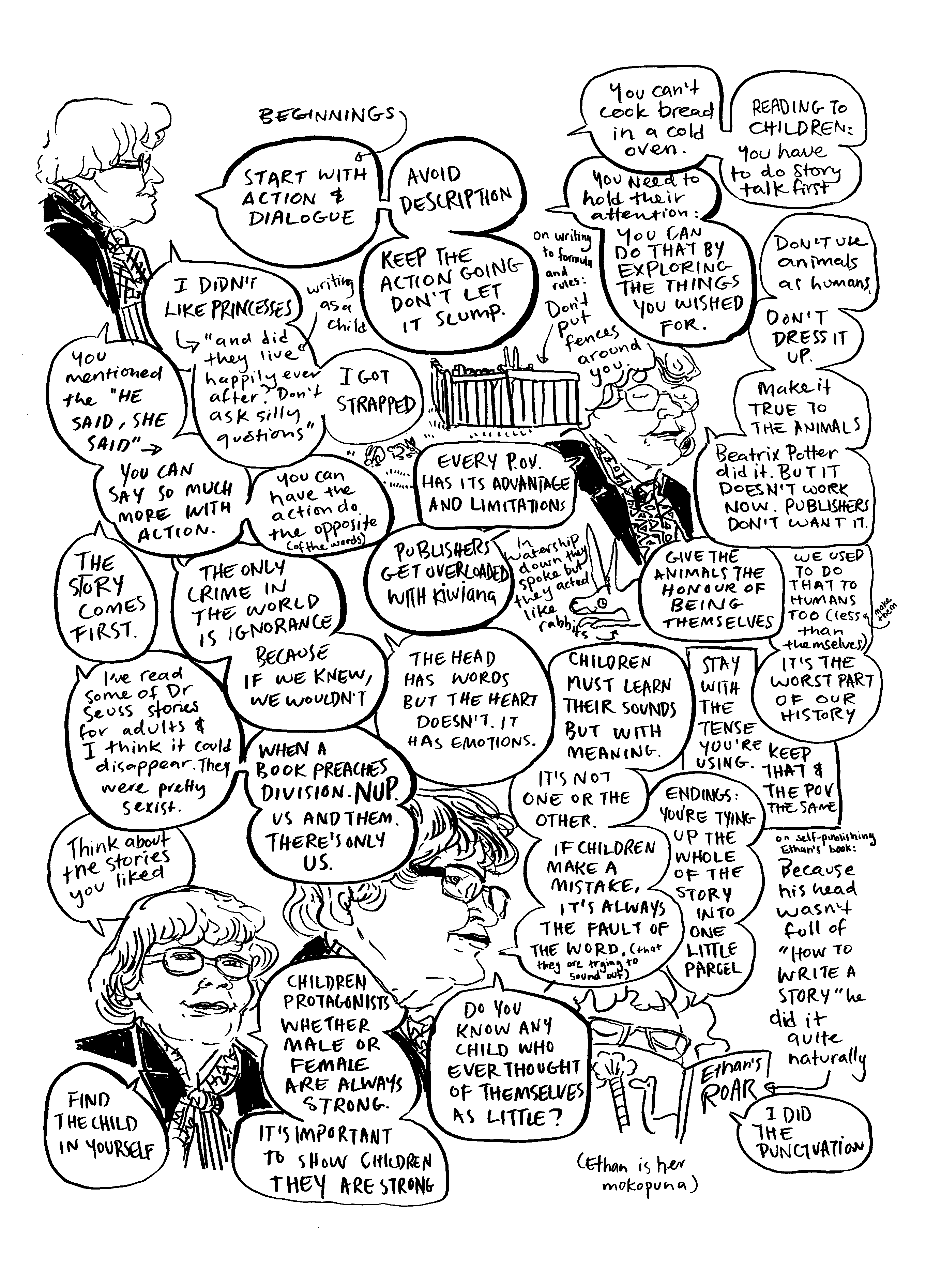
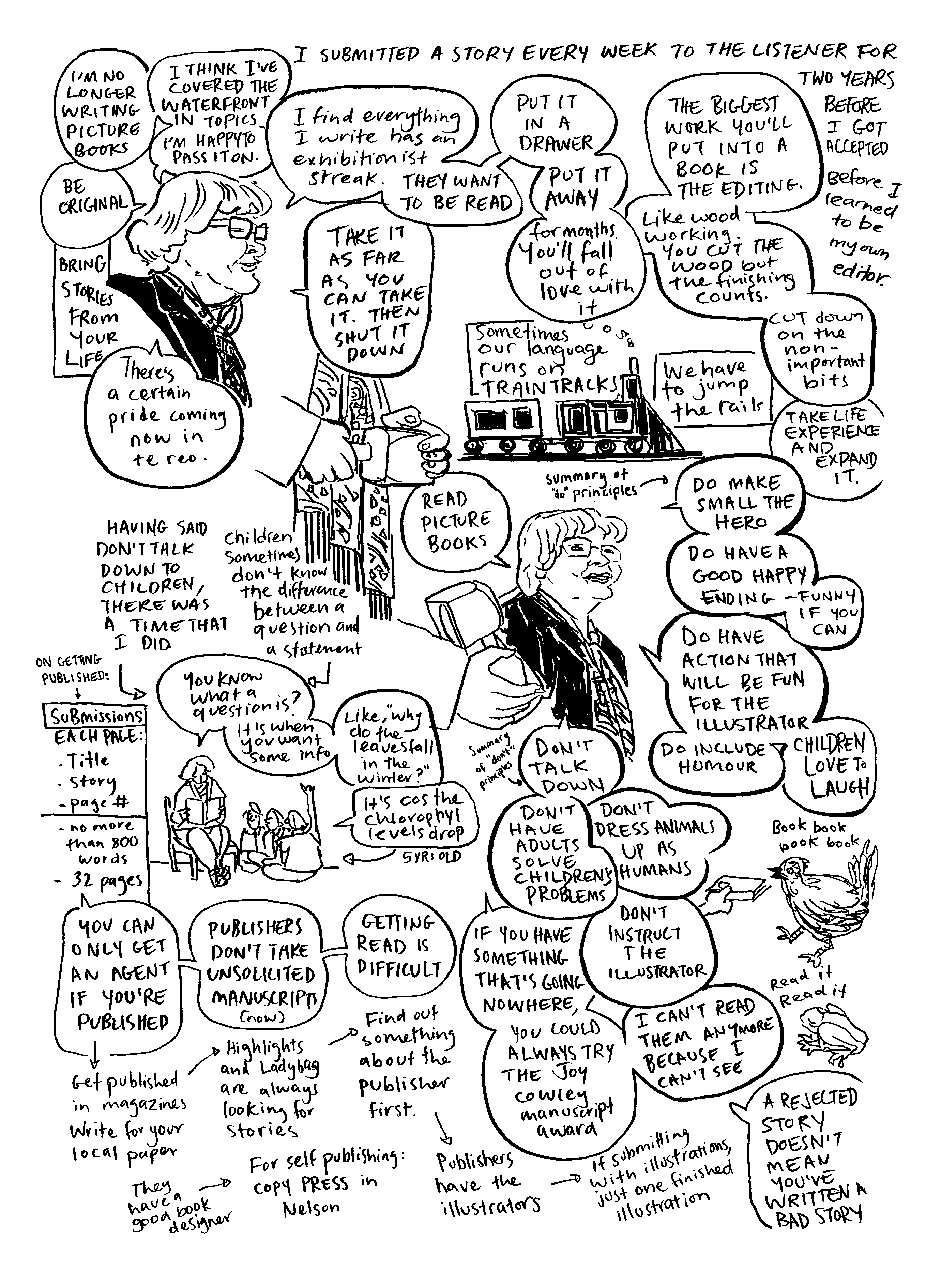
Joy Cowley Masterclass
All words are Joy’s unless otherwise indicated. All drawings and interpretation are by Tara Black.
[Image of Joy’s top and scarf illustrated] Choose one child you know very well. Write for that child and you’ll get it right.
It’s good to see so many people interested in writing for children – and men. We need men interested in writing for and reading to children.
How can I explain? My left eye has 40 percent vision, my right eye has none. I can’t see my friends. I can’t read manuscripts.
You are going to be searching for memories of the funny side of life. Quite often the unresolved, and difficult things come up first. Put those in a journal.
I’ve been delighted by how the illustrator expands my work.
No child is reluctant to read a story they’ve written.
I see sometimes shopping list books. It’s not very interesting for children. When her son was behind in reading, he had met failure too many times. These children would freeze. So we started with story talk.
Use simple language to advance the story. 7 year olds like word games. 5 year olds like slapstick humour—you need an audience. There are two kinds of picture books – trade (for shops), and educational (for reading programmes, series ’that build on vocab.’
Any book is a multiple of 8 pages. Picture books have 32 pages. [image of a page divided into 4, front and back] That’s the structure. Don’t put into words what can be put into pictures. The illustrator is a co-author. Publishers want no more than 800 words.
The most popular writers use child language. [picture of a fork skewering a slice of ham] Children love everything from parents to pizza. I used to record children to study their speech. Pick up on child language.
Things need to move from left to right. The words need to be next to the nouns. For example if you have a Duck [illustrated], you can’t have another bird on the page.
Come up with an idea. Where did the idea come from? An idea that is popular? [illustrated dinosaur] That’s okay, but that’s second hand. Write about what is familiar to you. There’s something in us that likes to do rhyme. It’s very hard. A rhyme needs to be simple and direct. You get bogged down. It’s difficult to get a crisp story. You end up with extra words. Also, a publisher is likely to put that to one side—they get so many.
[page 1]
Jot down something that appeals to you. Sometimes they’ll mean nothing later. Do keep a note book.
[Image: Joy is standing and speaking into a microphone] Children love humorous words. Words that are fun!
Spend time working on the language. You don’t have to use rhyme. You can use rhythm. If you have a story that happens all in one place, it’s not a picture book. [image: Tiger moving behind a bubble] words beside the tiger: my tiger usually eats cake. “my tiger ate the dental nurse.”
When you get your story down, you need to paginate it. (32 pages) [image of 32 page grid]
The rule is, when you are writing, small is always the winner. I don’t allow adults to solve small’s problems. You’re giving a child strength [image of a child lifting weights], a small can solve an adult’s problems.
Phillip Webb says “We don’t put children in bad lights.”
What is the climax at the end? Try, when you’re writing, aim for a positive ending, or a surprise or something funny. [image of frogs with words ‘and they lived hoppily ever after’]
You have to make something specific happen. What happens in the story? What’s the point? Very often I’ll have a background for years before it becomes a story.
Where’s the humour? Ideas don’t come fully made. You have to work on them. I love hearing how stories start.
The English language is so great because it is a peasant language. SO many things sound like what they are.
Once your story is on paper, build in rhythm and sound. A picture book is always read aloud. Do the words sound like the feeling of the book? It’s the sound that’s important.
Talking about Nickety-nackety-noo-noo-noo ‘An ordinary story gets elevated by its pictures.’
Story structure [image beginning at bottom of sharp mountain, middle slightly after the mid-point, then drop to the end.] Build slowly to the middle.
That’s how I structure chapters too. It takes time to come up with a plot to go with your scenario. Then you practise with the language.
Being an adult can be a serious affair. We forget what it’s like to be a child. Being a child is difficult. You try to be so earnest and people laugh at you.
Exercise: Spend 10-15 minutes thinking of something that happened in your family. A celebration maybe. How old were you? I’m encouraging you to look at life experience. It’s a positive story and it’s got something funny. Give it a happy ending.
[page 2]
How did you get on with your writing exercises? Did you feel like you were back at school?
Sometimes you can’t publish a story. Some of my stories didn’t make it. Beware of “message” stories. They were the ones I liked the most—but I was trying to give a message.
We all have a history of moments.
I became addicted to reading. I used to balance my book on the handle bars until the inevitable happened [Image of young Joy on bike, with book]. That’s a story I could never write. I didn’t want to discourage reading.
Titles matter – the windy windy road [image: wind swishes, then image: wiggly road] doesn’t work.
A voice is “how you tell your story”. Old folktales have a distant voice. [Joy is pictured seated, talking to Phillip Webb who is leaning towards her]
When you were learning to read, you read to the end. Think about line breaks – you read to the end of the line. And then you took a breath. If you don’t have the line breaks, it can become meaningless.
Exercise: read your story aloud. I want you to hear them. A child wants to read a line in one breath [image of a child viewed from above].
I used to go into schools on Native American reservations. I couldn’t make tortillas. You don’t go into another culture and just use [this is a speech bubble coming from Joy in profile]
When I do nature books I have to do the pictures first. It’s tempting to personify or add emotions on animals in picture books. Image of book ‘Red Eyed Tree Frog’ – it’s a scientific book. The drama comes from action. It can’t have emotion.
[image of Joy reading ‘Gracias the thanksgiving Turkey’] No one can kill a turkey who has been blessed.
Think about a suitable voice:
– Are you a bright and noisy kid?
– Does it need rhythm?
[page 3]
[Joy in profile]
Beginnings – Start with action & dialogue. Avoid description. Keep the action going. Don’t let it slump.
You can’t cook bread in a cold oven. Reading to children: you have to do story talk first.
You need to hold their attention: you can do that by exploring the things you wished for.
On writing to formula and rules: don’t put fences around you [image of a fence]
I didn’t like princesses as a child. “and did they live happily ever after? Don’t ask silly questions” I got strapped.
You mentioned the “he said, she said” – you can say so much more with action. You can have the action do the opposite of the words.
The story comes first. The only crime in the world is ignorance. Because if we knew, we wouldn’t. The head has words but the heart doesn’t. It has emotions.
I’ve read some of Dr Seuss’ stories for adults and I think it could disappear. They were pretty sexist. When a book preaches division: nup.
Every POV has its advantage and limitations. [image of rabbit] In Watership Down they spoke but they acted like rabbits.
Children must learn their sounds but with meaning. It’s not one or the other. If children make a mistake, it’s always the fault of the word.
[Illustration of Joy face-on] Think about the stories you liked. Find the child in yourself.
Children (sic) protagonists whether male or female are always strong. It’s important to show children they are strong. Do you know any child who ever thought of themselves as little?
Stay with the tense you’re using. Keep that and the POV the same.
Endings: You’re tying up the whole of the story into one little parcel.
Don’t use animals as humans. Don’t dress it up. Make it true to the animals. Beatrix Potter did it. But it doesn’t work now. Publishers don’t want it.
Give the animals the honour of being themselves. We used to do that to humans too (make them less than themselves). It’s the worst part of our history.
Publishers get overloaded with Kiwiana.
On self-publishing Ethan’s book (Ethan is her mokopuna) Because his head wasn’t full of ‘how to write a story’ he did it quite naturally. [image of Joy reading ‘Ethan’s Roar’] I did the punctuation.
[page 4]
I submitted a story every week to the Listener for two years before I got accepted. Before I learned to be my own editor.
[image of Joy with dark top and scarf] I’m no longer writing picture books. I think I’ve covered the waterfront in topics. I’m happy to pass it on.
I find everything I write has an exhibitionist streak. They want to be read. Take it as far as you can take it. Then shut it down. Put it in a drawer. Put it away for months. You’ll fall out of love with it.
The biggest work you’ll put into a book is the editing. Like wood-working. You cut the wood but the finishing counts. Cut down on the non-important bits. Take life experience and expand it.
[Image with train] Sometimes our language runs on train tracks. We have to jump the rails.
Be original. Bring stories from your life. There’s a certain pride coming now in te reo.
Having said “don’t talk down to children” There was a time that I did. Children sometimes don’t know the difference between a question and a statement.
[picture of Joy reading to children, saying You know what a question is? It’s when you want some info. Like ‘why do the leaves fall in the winter’. Kid with hand up age 5 says ,’It’s coz the chlorophyll levels drop.’]
Summary of “do” principles:
Do make small the hero.
Do have a good happy ending – funny if you can.
Do have action that will be fun for the illustrator.
Do include humour. Children love to laugh.
[image of Joy]
Summary of don’t principles:
Don’t talk down.
Don’t have adults solve children’s problems.
Don’t dress animals up as humans.
Don’t instruct the illustrator. [image of a chicken saying ‘book book book book’ pecking a book’, and below that an image of a frog saying ‘read it. read it.’]
[page 5]
On getting published: Submissions need Title, story, page # on each page, no more than 800 words, 32 pages.
You can only get an agent if you’re published. Get published in magazines. Write for your local paper. Highlights and Ladybug are always looking for stories. Find out something about the publisher first. Publishers have the illustrators. If submitting with illustrations, just one finished illustration. They have a good book designer, but for self-publishing, use Copy Press in Nelson.
Publishers don’t take unsolicited manuscripts now. Getting read is difficult. If you have something that’s going nowhere, you could always try the Joy Cowley manuscript award. I can’t read them anymore because I can’t see.
A rejected story doesn’t mean you’ve written a bad story.
On making time to write:
You’ll want to clean. Just sit there. Even if you don’t have any ideas.
Give your writing your peak energy time. You can’t write well with the dregs of the day.
Ali Foster, who was at the workshop, shared a letter from Joy Cowley. [illustration of Ali with short spiky hair and a pendant]
Joy also sent her a book, called Speaking of writing… Seventeen leading writers.
Don’t write to get published. A writer is nothing else but a catalyst for life. If her experience is thin, so will her writing be.
She wrote this to me in 1976: There are no rules for success. If someone had told me that the secret is experience I would have been depressed. Get a job with lots of people.
Endplate:
Joy Cowley Masterclass, hosted by Featherston Booktown, 6 March. Illustration of Featherston Booktown logo.
[Joy image, she is holding flowers, with text]: Thank you for supporting Booktown. There’s a world of children who will be blessed because of you.

Tara Black
Tara Black can often be found in the front row of book events, illustrating authors and their ideas. She has an MCW from Massey University and loves fried potato. Her first graphic novel, This Is Not a Pipe, is out now from VUP. Image: Ebony Lamb



